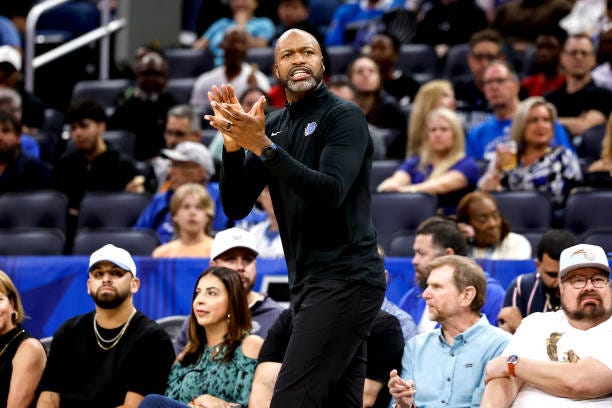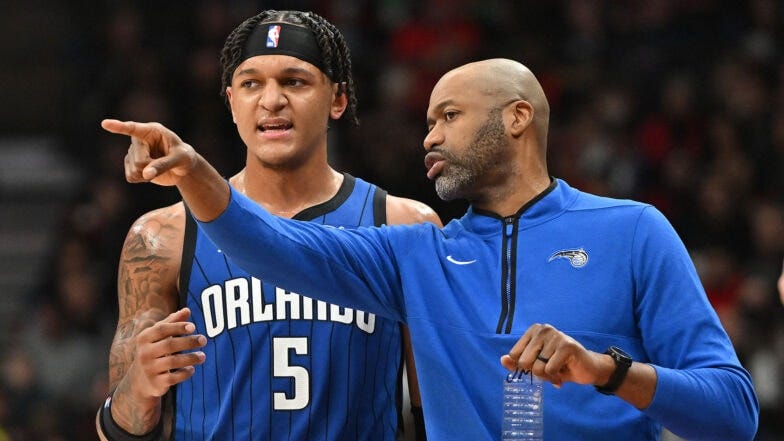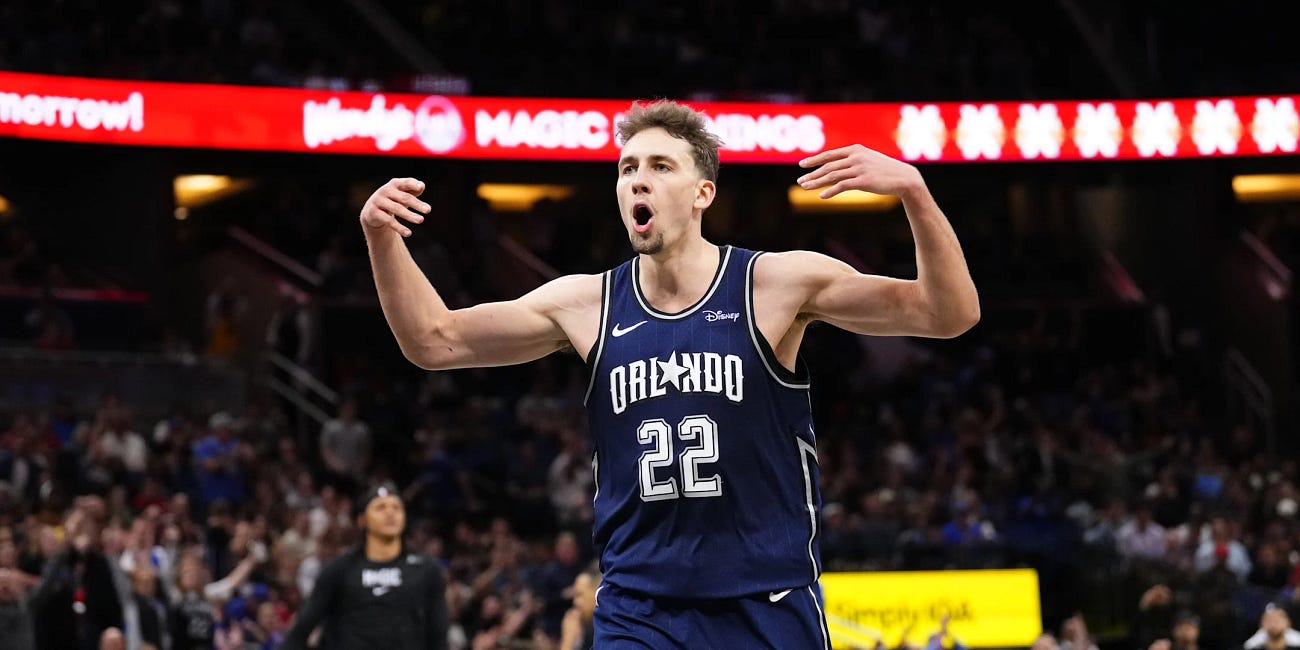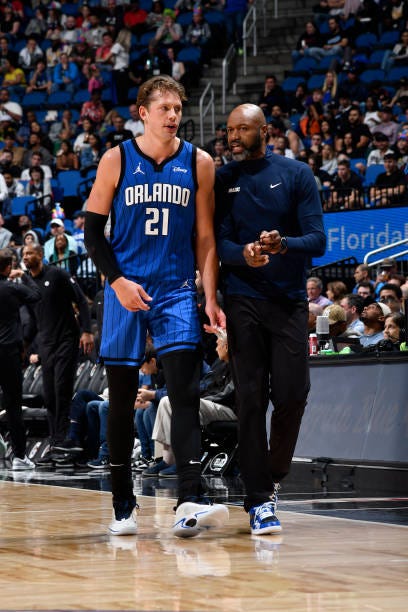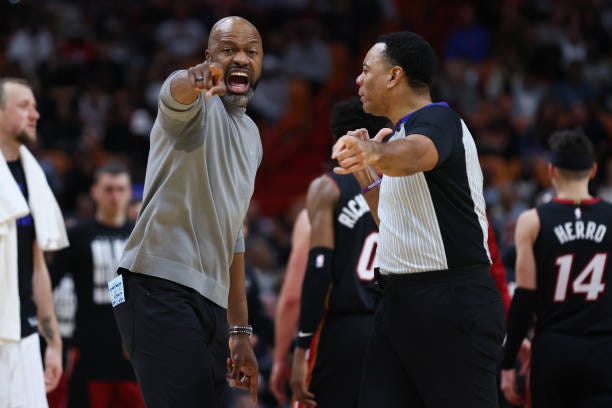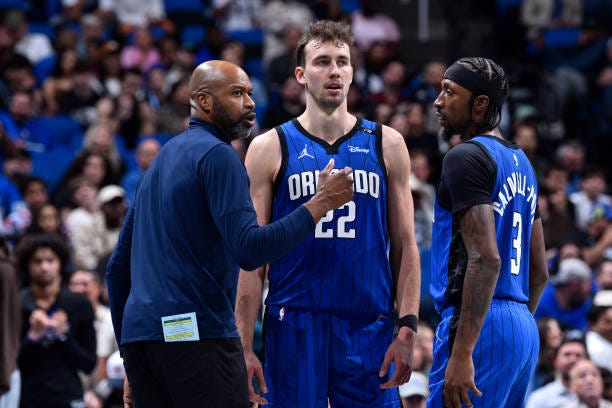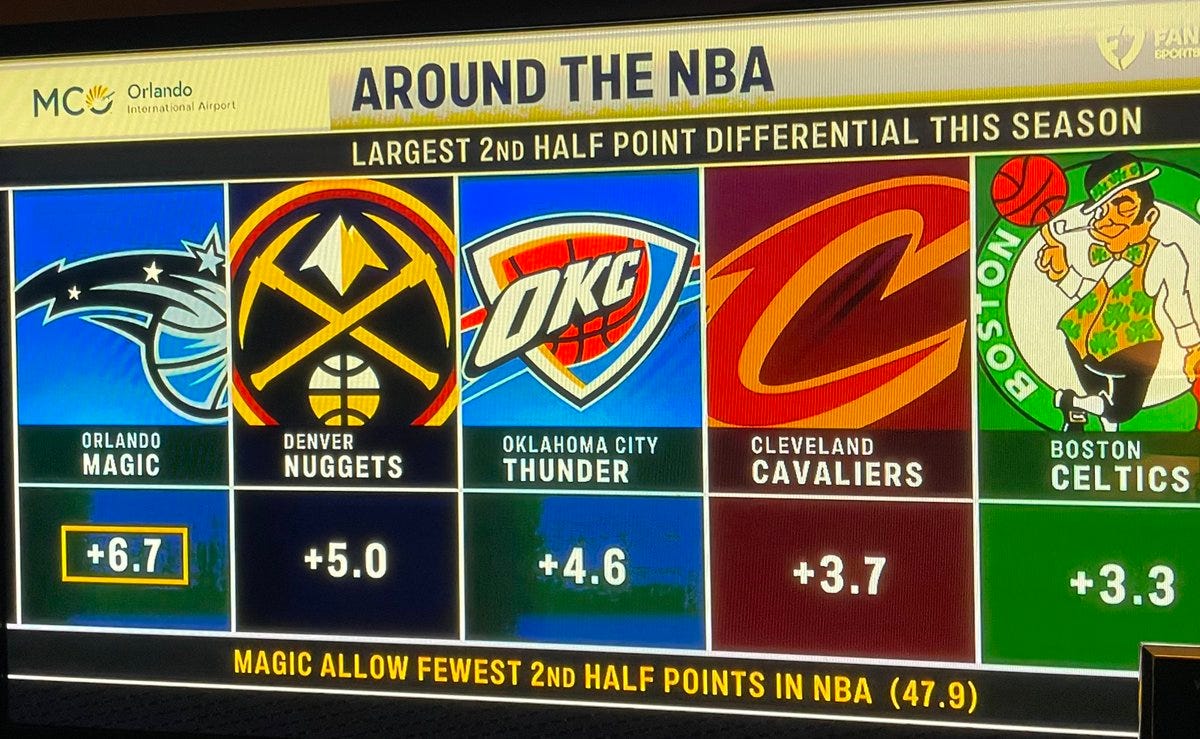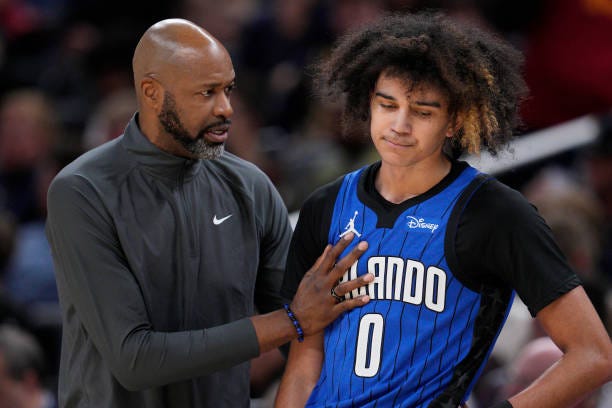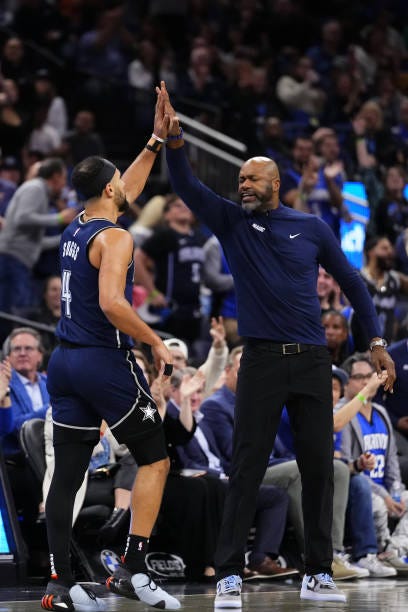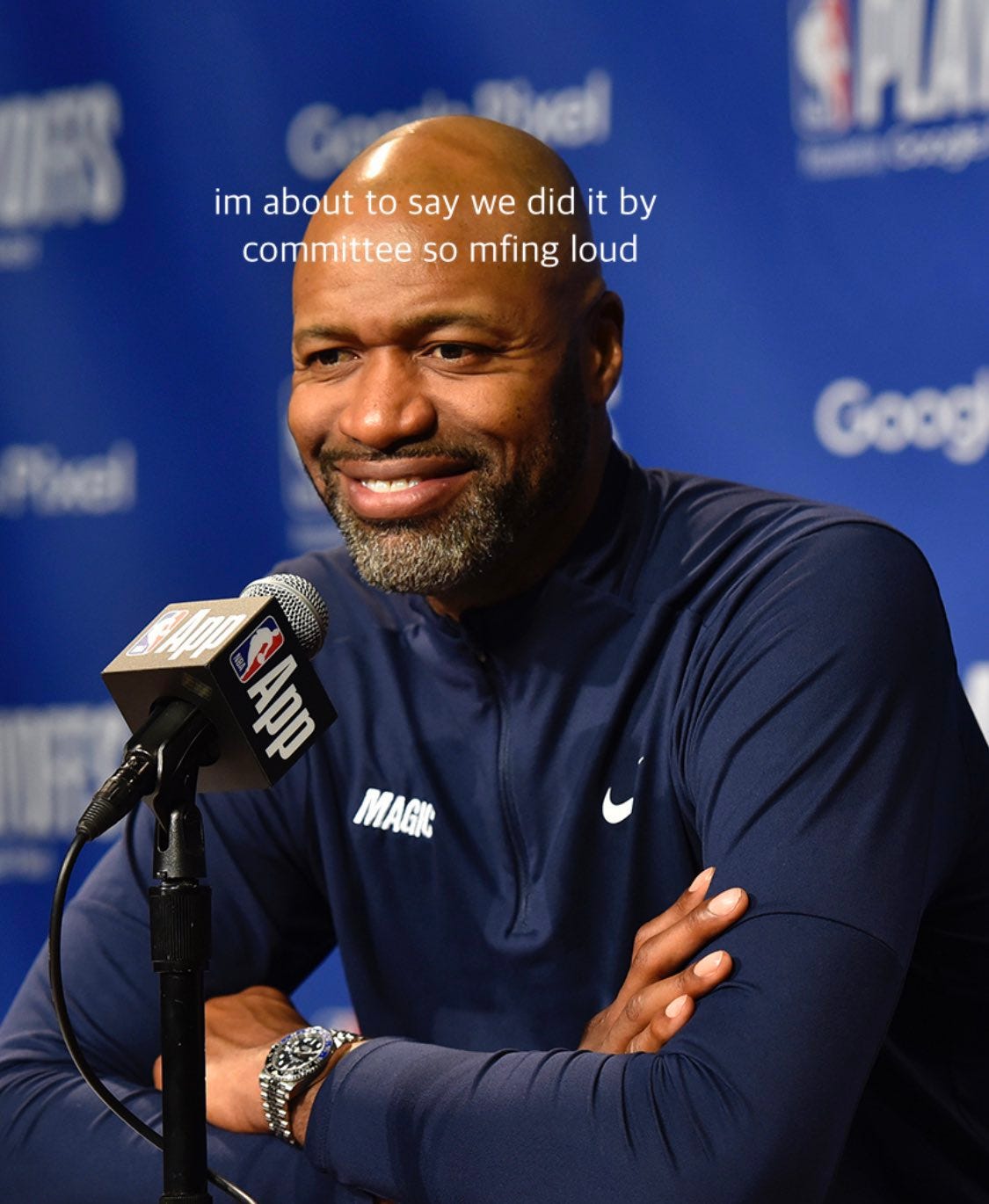10 Reasons Jamahl Mosley Deserves to be NBA Coach of the Year in 2025
Orlando Magic Head Coach Jamahl Mosley continues to defy the odds with an injury-riddled team that would still have home court advantage if the playoffs started today
Energy.
Trust.
Preparation.
Lineups.
Depth.
Resilience.
Clutch.
Defense.
Home.
Hope.
1. Energy.
He brings genuine positive energy to the locker room that players buy into, that spreads like wildfire throughout the building
I asked Anthony Black and Cole Anthony what Coach Mosley brings to the locker room that’s noticeably different than other coaches that keeps the whole team resilient, fighting to the end every single possession, never giving up on a game:
Anthony Black:
“Just good energy. He got us believing in ourselves every night out there as we should. He just comes in with a lot of energy towards the gameplan towards the other team. He just instills a lot of confidence in us to just go out there and play aggressive, and just play freely, and really just to have fun.”
Cole Anthony on the Jamahl Mosley’s energy being contagious:
“…I told Mose this a couple days ago, this all starts with him. I told him earlier today, ‘I was like, yo Mose, I like your energy today,’ I said, ‘that joint’s contagious! that’s gonna rub off on everybody.’ I told him that, and that’s literally what happened. Everybody was distracted a lil’ bit, yeah we got off to a rough start, but dudes locked back in. I give so much credit to Mose just for keeping us engaged. Yeah, once again, big shout to Mose.”
2. Trust.
He trusts his high feel players to make reads, make decisions on the court, make up plays on the fly.
I asked Jamahl Mosley how Sequencing factors into his play-calling, with his answer in the video below:
"It’s part of the game; it’s the game read; it’s the game feel.
It's part of also why you allow these guys to be themselves on the floor, because they feel it a lot more than a lot of times than the coaches do.
So if they see something they recognize after one play was called, they also know the counter to what that may look like because of what the defense has done, and this is why you get guys with high basketball IQs, because they can register and realize those things real time, versus the coaches always having to point it out for them."
With 7 MIN left against Phoenix, Orlando trailed 97-95.
Until Jalen Suggs happened, and The Magic never trailed again.
Despite averaging only five pick-and-rolls per game, Jalen ran TEN in the final seven minutes, drilling two pull-up ‘trees’, driving for two layups, drawing four fouls, converting 4/5 FT at the line, contesting six shots on defense, and helping his team force a shot clock violation: Clip of Jalen Suggs’ Final 7 MIN stretch vs. PHX
He answered for 90 seconds in the video below:
"It was a beautiful opportunity tonight to continue working on and applying everything I've been working on."
Tristan Da Silva’s been Orlando’s 2nd leading scorer over the past seven games, putting up 15 PPG.
Da Silva put up a Career-High 21 PTS to help will a 21pt comeback against the Nets. Here’s a clip of one possession where Tristan da Silva orchestrated the offense, saw a matchup he likes, and called for a Double Drag, creating a hockey assist to himself for a C&S three, broken down with film analysis by Yashwant Sathish Kumar
3. Preparation.
He sets players up in the best position to succeed when opportunity strikes
Orlando’s front office made an important decision this off-season: to prioritize their depth, matchup versatility, continuity and chemistry by bringing back their batch of big men for slightly more total annual salary as it would’ve taken to sign the biggest center name on the free agent market, Isaiah Hartenstein, who ended up in OKC.
Between Jonathan Isaac’s 4-year extension ($14.8 M/yr), Wendell Carter’s 3-year extension ($19.5M/yr), Mo Wagner’s 2-year Team Option deal ($11M/yr), and Goga Bitadze’s 3-year deal ($8.3M/yr), Orlando brought back four players who all bring a little something different to the frontcourt for an annual average of $53.6M.
The annual salary for Hartenstein’s 3-year deal with the Thunder was $30M/yr. One could say Orlando could have entered a bidding war for the big name big man, and still retained one or two of their own guys.
Instead, this decision to maintain depth gives Jamahl Mosley’s coaching staff more options to play with, where player availability, matchups, and individual skill-sets all factor in to which center will start on any given night, rather than put all of the team’s eggs in one basket.
One could argue Goga Bitadze has even given Orlando a similar high-impact defender, big brute rim-protector, and play-finisher with connector playmaking chops option as Hartenstein would have, while costing less than 1/3 of the salary, allowing Orlando to spend on depth to combat possible injuries and provide lineup alternatives.
With the sad loss of Mo Wagner for the rest of the season to a Torn ACL, this has further shown to be wise roster-building decision.
Before the season, Wendell Carter Jr. was the incumbent starting center.
After going down to injury, Goga once again stepped up as the fill-in starter, jumping from third string to the jump ball.
In terms of actual impact within their roles this season, Bitadze and Hartenstein have been nearly identical according to Dunks and Threes’ Estimated Plus Minus metric:
Goga now has a +2.6 Defensive EPM rating, ranking 8th among all players; Isaiah has a +3.3 Defensive EPM rating, ranking 3rd.
Bitadze’s overall impact of +3.4 EPM rates in the 94th percentile of all players, just a smidge ahead of Isaiah’s +3.3 EPM rating in the 93rd percentile.
Goga Bitadze, Orlando's Unsung Understudy
Not every team has one starting-caliber center, let alone multiple.
Paolo Banchero opened up the season looking ready to make an All-NBA level leap, albeit in only five games before going down to injury.
In a Career-High 50pt BANG against Indiana, Paolo tied Magic Legend Tracy McGrady for the most points scored in one half (37 PTS), shooting absolutely unconscious from the field with tough pull-up after tough pull-up.
Whether it’s due to his impressive start to the season or rising popularity around the league, Paolo currently ranks 4th in All-Star voting among all East Frontcourt Players.
With more shots available and the Magic needing to find offense without Paolo, Jalen Suggs initially took it upon himself to put the team on his back.
Suggs has exploded for two Career-Highs of 28 PTS & 31 PTS in Banchero’s absence.
This year, Jalen has improved on the ball, scoring 0.86 PPP in 187 Pick-and-Roll Ball Handler poss (55th percentile) and 0.95 PPP in 44 ISO poss. (71st percentile)
A few games after Paolo went down to injury, it was eventually Franz who stepped up as the team’s primary offensive engine, as both the main scoring option and team’s most reliable halfcourt shot creator.
After a 5-game road stretch of the team figuring out their new identity sans their franchise player, they finally put the ball in Franz’ hands and let the chef cook, winning six straight games and extending the home win streak to ten straight.
Wagner let loose, taking control as the team’s primary scoring creator, the team’s main shot-creating hub who set up just about every shot for the team as a near-heliocentric option driving into the paint, drawing fouls, scoring at the rim, and kicking out to open shooters.
Franz made a clear case as an All-Star level player through 25gp, before he too went down, eerily falling victim to the same injury as Paolo with a torn oblique.
In 20 games without Paolo, Franz averaged 26 PTS - 6 REB - 6 AST - 2 STL
Franz consistently filled up the box score in a way only real stars can.
With a marquee moment game-winning stepback triple against LeBron’s Lakers in L.A. for good measure:
On the season: (25gp)
Averaging 24 PPG – 6 RPG – 6 APG – 2 SPG
Launching 6 3PA per game
Drawing 5 FTA per game
Seeing over a 15% AST% increase from his career average to 32.4% AST%
Ranking 7th in Overall Impact (+5.1 EPM)
Creating 1.27 PPP in 33 Post-Ups including passes (90th percentile)
Creating 0.98 PPP in 310 Pick-and-Rolls including passes (58h percentile)
Scoring 1.55 PPP on 49 Cuts (83rd percentile)
Scoring 1.07 PPP on 75 Spot Ups (56th percentile)
Leading a Top-3 seed in the conference at the time (now sitting at 4th)
Franz Wagner was headed to his first all-star game, full stop.
Fans of the sport noticed, as Wagner currently ranks 7th among East Frontcourt Players in the first returns for All-Star voting.
We Have All-Star Franz Wagner At Home
The last time the Magic lost a basketball game in Orlando, Shaboozey hadn’t even dropped his #1 Hit, “A Bar Song (Tipsy)”.
4. Lineups.
He’ll try any lineup necessary to win a game
Jamahl Mosley’s hand has been forced with so many injuries to key rotation players; the Magic have already used 11 different starting lineups while trying out over 300 different lineup combinations on the year!
As of the first day of 2025, Orlando has played 16 lineups with at least 20+ MIN together, tied for the 9th most of any team, though Denver nearly doubles any other team in this stat with 29 different 20+ minute lineup combinations!
Nine teams have played at least four different lineups for at least 50 minutes together; the Magic are one of them.
I asked Jamahl Mosley if 3-man combos factor into his lineups decisions:
I asked Cole Anthony how comfortable he is leading the offense when his number is called upon:
5. Depth.
He’s maintained one of the best bench units in the NBA
Normally when the bench checks in, players feel a sigh of relief that the defensive intensity might turn down a notch; against Orlando, instead they see Jonathan Isaac walk up to the scorer’s table to check into the game.
Last season, the two-way lineup balance and maintained chemistry was a key part of Orlando’s second unit’s high net rating.
Cole Anthony held the reigns, leading one of the most impactful bench lineups in the league as their most reliable shot creator.
Cole took turns running pick-and-rolls/pops with Joe Ingles, who built real chemistry with Mo Wagner in the two-man game. With Jonathan Isaac anchoring the defense and the fifth spot usually held by Rookie Anthony Black, Gary Harris, or Markelle Fultz, the bench always had solid rotation players who competed defensively and made the right play for the team offensively.
Now, Joe Ingles is off to Minnesota; Anthony Black has more responsibilities as the tall point guard/point forward.
This cohesive second unit isn’t quite as impactful by net rating as last year, but the bench is still scoring the rock.
This stat may surprise folks: Orlando’s bench has the 5th-best offensive rating of any bench in the league this season.
Orlando ranks 6th (38.7 PPG) in Bench Scoring, just 0.1 behind Detroit (38.8) for 5th.
The Magic’s bench takes the 4th-most shots and 5th-most free throws of any team.
Orlando’s second unit gets buckets!
Jamahl Mosley maintains floor balance on this second unit, too, as the team’s bench racks up the 2nd-most blocks (2.8) of any team, just 0.1 BPG behind the league-leading Memphis Grizzlies (2.9).
Again, one of the league’s premier shot-blocking impact defenders, Jonathan Isaac, anchors this team’s second unit.
In one extremely small sample size of 20 MIN played together this season, the lineup of Anthony Black - Gary Harris - Franz Wagner - Mo Wagner - Jonathan Isaac is posting a staggering +43 Net Rating with a 70 D-RTG and 114 O-RTG.
Mo Wagner was making a strong case as the NBA’s sixth man of the year, a vital scoring option for Orlando all year.
Moritz was putting up 13 PPG off the bench, scoring at a super efficient rate of 65% TS%, while shooting 56% FG% from the field and 37% 3P% from deep on 2.5 3PA/gm.
Just before Christmas, Wagner was rolling, dropping a Career-High 32 PTS against the Knicks, with season highs of 10 FGM/15 FGA, 4 3PM/7 3PA, and 8 FT/11 FTA.
Mo scored in double digits in 23 of his first 29 games played, before sadly going down with a season-ending injury just a minute and a half into his 30th game against Miami.
The Wagner Brothers were the Top-2 Leading Scorers for Orlando 7 times already this season.
When Orlando has enough personnel available to be able to stagger Franz alongside the bench, the team’s been able to maintain two-way balance while unleashing an All-Star level player on unsuspecting bench players.
Usually The Wagner Show helps each other score through chemistry in the 2-man game, whether it be a plain ol’ pick-and-roll or handoff, or a set involving another teammate like Horns, Zoom, Chin, or one of Coach Mosley’s go-to plays: Double Drag.
Coach Mosley especially likes to run Double Drag with the second unit, probably to increase the likelihood of creating a good shot for the team out of a simple yet effective set that is essentially just a double pick-and-roll: two screeners set up on the same side of the ball-handler; one pops for three and the other rolls to the rim.
Magic fans will often see Anthony Black or Franz Wagner initiate these sets to get the tall forward creators a slight advantage on the move; making their man run through two screens and forcing the defense to show their cards; breaking the ball-handler’s decisions down to a handful of straightforward options to either drive into the paint, kick out to a shooter, or make a dumpoff pass to the roller or a cutter.
6. Resilience.
His team never quits
The Comeback Kids
How often are you watching an NBA game where a team goes down fifteen or twenty points, and you start to notice players throwing in the towel?
This Magic team leaves their towels in the locker room.
This team’s culture is defined by its resiliency.
They leave everything on the court.
They don’t know how to turn off the gas.
What’s the secret?
Cole Anthony and Anthony Black credit the energy Coach Mosley brings to the locker room as the secret sauce that keeps this team motivated, focused on the task at hand, dialed in on daily player development to help from getting lost in the hopelessness of a big deficit in the middle of a game or the haul of the gruelingly long NBA schedule.
Clearly, Coach Mosley brings a high level of communication that reaches today’s player in a motivational manner, perhaps focusing on positive outlook and getting better each day rather than screaming negativity about past results.
Credit to the front office led by Jeff Weltman, Anthony Parker, and formerly John Hammond for doing a phenomenal job of finding not only good basketball players who are ready to step in at a moment’s notice and willing to play hard on both ends of the floor, but good teammates who are willing to sacrifice for the good of the team, who root for the “success of the man next to them”, as Cole Anthony put it.
Orlando’s fought back from seven double-digit deficits this season, with four coming in the last ten games.
Orlando’s never-out-of-a-game, never-give-up mentality has been a staple of the team’s mindset since Jamahl Mosley was hired, with this trend kicking into overdrive over the past ten games.
What’s happened in the last ten games?
That’s the stretch where Orlando’s been forced to compete without its two budding big wing stars available in Franz Wagner and Paolo Banchero.
On top of that, Orlando’s lost Mo Wagner for the season and other key players for a game or two in this stretch, from a Suggs wrist injury and an Anthony Black back spasm to quick questionable ejections for Wendell Carter and Goga Bitadze.
Orlando’s trailed by double digits in nine of those ten games, and despite the adversity, they’ve given themselves a chance to win every game but one, coming back for four wins (+5, +7, +4, +1), making close contests out of four losses (-5, -9, -6, -1, -9), while letting one loss get away from them. (-23).
This Magic team never quits; it defies the odds; it exceeds expectations.
This team tied a record set in the first year of the franchise’s existence (1989) for the biggest comeback win in team history after being down 25 PTS to the Miami Heat.
Dropping a Season-High 35 PTS with 9 AST and 8 REB, Ice Cole Anthony took over the game, individually creating almost every shot Orlando took in the second half, especially in the fourth quarter.
Down 12 versus Booker’s Suns? Time to unleash Jalen Suggs on 10 pick-and-rolls in the final seven minutes of the fourth after averaging only 5 P&Rs per game all year.
Down 15 against the reigning champion Boston Celtics on their home turf? No problem, time to ride Rookie Tristan Da Silva to a Career-High 21 PTS and unleash Trevelin Queen as the team’s Top-2 scorers in literally the first start of his pro career.
Down 21 PTS in the 3rd quarter to the Nets? Losing a key player to injury the rest of the game? Missing five of the team’s six top scoring options?
As David Steele and Jeff Turner joked on the broadcast, Orlando had Brooklyn right where they wanted them.
The Magic went on a 22-4 run to close the fourth quarter with a game-winning FLOATA from Ice Cole Anthony:
7. Clutch.
He coaches The Best 4th Quarter Team & The Best Second Half Team in the NBA
Second Half Magicians
The Orlando Magic share the best record (8-11) with the Denver Nuggets when trailing at halftime and hold the best record (6-12) when trailing after three quarters.
For whatever reason, this Magic team turns up the heat in second halves; they seemingly play better when they’re losing than when they’re ahead.
Why, exactly? Who knows.
Maybe Coach Mosley’s going full Any Given Sunday mode, dropping the most inspirational locker room speech you’ve ever heard, with new material every game.
What we do know is what the Magic are doing on the court to stay in games:
Forcing Stops.
By ranking 1st in defensive rating, 1st in securing defensive rebounds, and just 0.1% TOV% behind 1st in forcing turnovers, we can conclude the Orlando Magic are the best 2nd Half team at forcing stops this season.
For comparision, Orlando’s Second Half defensive net rating is a full 5 points fewer than second place and 10 points fewer than 3rd, and 24 points fewer than 30th!
Converting that to a half, that translates to the Magic holding opposing teams to 49.2 Second Half points, which is 2.5 points fewer than the 2nd best defense, 5 points fewer than the 3rd best defense, and 12 points fewer than the worst defense
The Second Half Rankings
1st in net rating (+11.7 Net Rating), beating teams by a 5.85 2nd Half Point Differential
Offense
3rd at drawing fouls (0.317 FTA Rate)
Defense
1st in defensive rating (98.4 D-RTG)
2nd in forcing turnovers (18.9% OPP TOV% , 0.1% behind OKC)
1st in securing defensive rebounds (25.2% OPP OREB%)
2nd in forcing missed shots (49.1% OPP eFG%)
Magic in the Fourth
Those numbers are especially dominant in the fourth quarter.
Orlando’s +16.1 4th Quarter Net Rating means The Magic are beating opponents by an average point differential of over 4 PTS in the fourth!
That’s a rate nearly double that of the 2nd and 3rd ranked teams, with the Cavs and Mavs next closest outscoring opponents by roughly 2.4 PTS in the fourth.
The 4th Quarter Four Factor Rankings
Orlando continues to excel at forcing stops:
2nd in Forcing Missed Shots (48.8% eFG% , 0.1% behind 1st)
2nd in Forcing Turnovers (18.1% TOV% , 0.1% behind 1st)
3rd in Defensive Rebounds (25.1% OPP O-REB% , 0.6% behind 1st)
The team remains above average at shooting efficiency and drawing fouls:
9th in Shooting Efficiency (54.5% eFG%)
7th at Drawing Fouls (0.34 FTA Rate)
No other team ranks Top-3 in in three different Fourth Quarter defensive four factors.
The next closest is the Thunder ranking Top-3 in two different factors, the Hawks ranking Top-7 in three different factors, with the Heat and Pistons rating Top-10 in three different factors.
The Orlando Magic are the best Fourth Quarter team in the NBA, the best Fourth Quarter Defense in the NBA, and the best Fourth Quarter stop-getters in the NBA.
8. Home.
His team doesn’t lose at home (very often)
The Magic were undefeated at home for most of the year.
Orlando is tied with the Cavs for the longest home win streak this season. (10 W)
Before the stars Paolo Banchero and Franz Wagner went down to injury, one would have to go back to April 1st, 2024 of last season to find the last time Orlando lost a game in their own building, a time before Shaboozey’s remix of ‘Tipsy’ even existed.
Once the injuries started piling up, that streak eventually came to an end.
Yet Orlando still holds the 4th-best home record in the league at 13-4 with the 2nd- best defense at home (103.9 D-RTG) of any team, just 0.1 behind OKC, with the 8th-best Net Rating (+7.3) at home. The Magic rate Top-7 in 2 of the 4 offensive four factors and 3 of the 4 defensive four factors when playing in front of their fans:
Offensively, The Magic draw the 5th most free throws of any team at home (0.274 FTA Rate) and grab the 7th most rebounds (.31% OREB%)
Defensively, Orlando holds the opposition to the T-6th lowest shooting percentage at home (51.9% OPP eFG%), forces the 2nd-most turnovers (18.2% OPP TOV%) and secures the 3rd-most defensive rebounds. (26.6% OPP OREB%)
This Magic team takes pride in defending the O-rena, putting on a show for the fans, with role players showing confidence playing in the gym they’re most comfortable in.
9. Defense.
His hustle culture “The Magic Standard” has generated an elite Top-3 Defense for the second year in a row.
Credit for elite defenses goes to everyone: to the front office putting together a roster of long, strong, smart defenders who know where to be; to the coaching staff for scheming the players into specific rotations, inspiring them to focus on the task at hand, instructing them to do their job while trusting their teammates to do theirs; to the players on the court playing the actual defense, executing the gameplan, possessing the instincts to make smart plays, get stops, and force turnovers.
Before Jamahl Mosley arrived, the Magic had the 4th-worst defense in the league. The first thing the new head coach did was bring a bell to practice that would be rung any time a player made a hustle play, setting the tone with positive reinforcement.
Before the team could “Play the Song”, the goal was to “Ring the Bell.”
In his first two seasons as Orlando’s Head Coach, Mosley’s hustle culture was clear – previous’ levels of effort were no longer acceptable, the standard of expectations had been raised; the team immediately jumped to the middle of the pack defensively, ranking 17th and 16th, respectively.
These past two seasons is where The Magic Standard began to really bear its fruit: Orlando posted the 2nd-best defense in the league in Mosley’s 3rd season, and that intensity has carried over to the 3rd-best defense thirty five games into this season.
The opposing team better win the turnover battle against Orlando, or else they’ll be fighting an uphill battle. Orlando generally creates more possessions than their opponent by forcing turnovers, getting stops, and grabbing boards.
The Magic hold the NBA’s 3rd-best Defensive Rating primarily due to three reasons: ranking T-3rd at securing defensive rebounds (25% Opp OREB%), #11th at forcing missed shots (53.9% Def eFG%), and T-2nd at forcing turnovers. (17.7% TOV%)
Jalen Suggs spearheads this elite defense year-to-year, going from averaging a pick-six good for a four-point swing every game last season to making a chasedown block from behind every game this year.
The All-Defensive guard secured the league honors last season, earning respect for his screen navigation at point of attack chasing opposing star guards around the court, like in this game against Denver disrupting the lethal 2-man attack of Jamal Murray and Nikola Jokic:
Now paired with Kentavious Caldwell-Pope in the backcourt this season, Suggs is able to freeroam a bit more often.
KCP can pick up the opposing star guard at point-of-attack, letting Suggs conserve some energy to run the offense while freeing him to use his all-world instincts to force turnovers in other ways, like jumping passing lanes in help defense and swatting shots from behind as one of the best rim-protecting guards alive.
Among guards, Jalen Suggs ranks T-4th in blocks per game (1 BLK) and 22nd in steals per game (1.5 STL)
As for impact, Suggs holds a +1.7 D-EPM, tied with Marcus Smart.
KCP comes in close behind with +1.4 D-EPM, tied with Joel Embiid.
Suggs (2.8) and Franz (2.7) both rank Top-50 in Deflections Per Game.
The average fan may not realize Franz is not just an elite scorer, but an elite defender, providing top-level wing defense while carrying the load for the team offensively.
Franz Wagner is 1 of 6 stars averaging at least +1.7 EPM on offense and defense, joining Victor Wembanyama, Evan Mobley, Jaren Jackson Jr., and Shai Gilgeous-Alexander. (Anthony Davis, Joel Embiid, and Alperen Sengun just miss that cutoff)
The amount of winning plays Wagner makes on both ends is uncanny, he’s truly an elite two-way wing on the rise.
Anthony Black has seen his role grown dramatically since his first season, going from sporadic fill-in starter minutes in year one, to a solidified bench connector role and spot-starter in year two after all the injuries.
Black’s 0.7 BLK/gm ranks T-12th among guards, just ahead of KCP’s 0.6 BLK/gm (T-20th).
Goga Bitadze (+2.6 D-EPM, 1.6 BLK/gm), Jonathan Isaac (+1.5 D-EPM, 1.2 BLK/gm), and Wendell Carter Jr. (+1.7 D-EPM, 0.6 BLK/gm) take turns anchoring the defense down low, leading the Magic to the most total blocks of any team in the NBA.
In a solid sample size of 217 minutes with Goga Bitadze AND Wendell Carter Jr. sharing the court together, Orlando has a monstrous +19.57 Net Rating, scoring at a 119.57 O-RTG and defending at a 100.00 D-RTG.
Welcome to Swat City.
10. Hope.
He’s given Magic fans real hope of seeing a sustainable contender built over the long haul
Every season Mosley has been Head Coach of the Orlando Magic has felt like a breath of fresh air in terms of the competitive product on the court. Each year has been the most exciting season since Dwight was around, until the next one came along.
Rookie Suggs struggled offensively as he battled injuries, but flashed improvement running handoffs and finishing at the rim, while immediately thriving as a ball of energy defender who was so constantly disruptive that opposing announcers felt the need to tell audiences, “y’know folks, he used to play football”, every time they tuned in.
Rookie Franz exploded onto the scene as a “high-floor role player” prospect who did the little things right and quickly developed pick-and-roll chemistry with Wendell Carter Jr., forming the Wagner-Carter Connection.
This was the most exciting season and team potential that Magic fans had seen since Dwight… until the next year.
The Wagner Carter Connection
Built as fragilely as a jenga tower or beaver dam, a basketball team’s pick-and-roll defense exists to disrupt the flow; to stop the flooding. Even with all the mud, sweat, and tears put into it, a base is only as strong as its weakest link. Defensive rotations can appear totally in sync; yet, with just one mistep, the whole…
In Mosley’s 2nd season, it seemed like Markelle Fultz’ career had been saved.
Markelle Middy was arguably Orlando’s most reliable halfcourt shot creator and their most trustworthy ball-handler in the clutch, able to knock down pull-up jumpers anywhere below the arc and use his high-level playmaking vision and feel to drive-and-kick to open shooters or leave no-look dumpoff passes into shooting pockets for trailing stretch bigs.
Cole Anthony embraced and thrived in the 6th man role, stabilizing second units as a reliable shot creator in his own right, threading the needle between getting buckets himself and creating a good look for the team through pick-and-roll shot creation.
Rookie Paolo flashed incredible traits on his way to 20 PPG and the Rookie of the Year award, from his tough shotmaking at any spot on the floor to his downhill force foul-drawing and paint-and-spray potential as a backdown postup hub.
This was the most exciting season and team potential that Magic fans had seen since Dwight… until the next year.
Mosley’s Year 3 is when everyone could see everything coming together.
The game slowed down for Jalen Suggs, who focused his energy on what he did well while dabbling in game reps to continue developing skills he knew were within reach.
Jalen developed efficiency in different playtypes like ISO, P&R Ball-Handling Transition, and Handoffs while becoming a sniper from downtown, launching five threes per game and knocking down 40% of his 3PA, after hitting just 21% and 33% on 4 3PA per game in each of the two years prior.
The Backcourt Ballhawk would see his effort rewarded by being named one of the top ten defenders in the game after being voted to his first All-Defensive team.
Jalen Suggs: The Backcourt Ballhawk
How many teams have an elite defense anchored by the shortest player in the lineup?
Franz maintained his two-way consistency while becoming as trusty of an offensive option as Paolo, with the Magic’s offense reliant on at least one of them popping off for 20+ PTS while finding teammates for good looks on any given night.
Wagner saw his numbers creep up to 20 PPG- 5 REB - 4 APG - 1 STL while hitting 85% FT% on 5 FTA and 57% 2P% on 11 2PA.
Paolo took a Year 2 Leap, making his first All-Star game after seeing his averages bump up to 23 PPG - 7 RPG - 5 APG - 1 SPG while drilling 34% 3P% on 4 3PA and hitting 73% FT% on 7 FTA.
This pesky Magic team went on to make the playoffs for the first time in years.
Banchero exploded for 31pt and 39pt outings in his first playoff series, putting his name on the postseason map.
Franz gave the team hope down 2-1 with a huge 34pt Game 4.
Then, with their backs against the wall, the Paolo-Franz-Suggs core combined for 75 PTS in a memorable Game 6 at home to push the series to seven, before being ousted by the red-hot Donovan Mitchell and his Cavaliers in Cleveland.
This was the most exciting season and team potential that Magic fans had seen since Dwight… unless this year’s even better?
Paolo Banchero's Magical Playoff Leap
In front of a roaring Orlando crowd, Banchero dropped 31 PTS to lead the Magic to a 39-point blowout over the Cavs in his first-ever home playoff game.
When over 120 Magic Fans were asked to describe what this playoff team meant to them, words and phrases like ‘Heart and Hustle’ came to mind:
Grit. Grind. Heart. Hustle. Hungry. Compete. Defend.
Chemistry. Belief. Development. Potential.
Get better every day.
Play through the whistle. Every play matters. No plays off.
Never too high, never too low, never out of the game.
The Magic Standard - Orlando Appreciates Culture Built By Head Coach Jamahl Mosley and Jeff Weltman's Front Office - 2024 Orlando Magic Fan Survey
What does The Magic Standard mean to you?
Jamahl Mosley could have been named Coach of the Year last season, leading such a young unproven team to a Top-3 defense and their first playoff birth in years.
This year, his Orlando Magic are 20-15 through 35 games. The team hold the 4-seed in the East with the 10th-best winning percentage in the league, despite playing 30 games without Paolo, 10 games without Franz, and 13 games without Wendell. The Magic hold the 3rd best defense in the league and get better as the game goes on as the #1 Second Half team and #1 Fourth Quarter team in the association.
No team forces stops when the game is on the line as well as the Orlando Magic.
Should the past three seasons affect Mosley’s Coach of the Year odds in his fourth season? Maybe not, but showing the standard set since his first steps walking through the door, the progression his players have shown since first coming together, and the development he’s helped spark along the way all help show that this year’s success isn’t an outlier – it’s the next step on the staircase to building a sustainable contender.
This year’s success isn’t due to just any one individual. It’s success by committee.
Sources:
Ryan Kaminski @BeyondTheRK for Data Viz, Film Breakdowns, Written Analysis
Photo Credit: Getty Images
Data: NBA Stats, Synergy, PBP Stats, Cleaning The Glass, Dunks and Threes as of 01.01.25 unless otherwise noted
Film: NBA Stats, Synergy, Crowdscout



